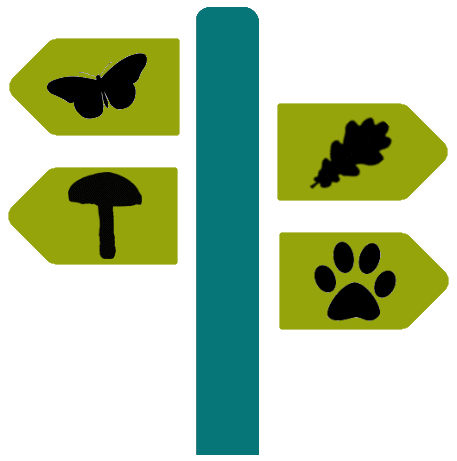ID Resource Resource Finder
The ID Resource Finder is an online searchable catalogue of UK wildlife identification resources. A key feature is that this catalogue is crowd-sourced, all you have to do is create an account to add/edit the resources.
If you spot anything missing, any broken links or mistakes then please jump in and add/fix it. Or let the team know about issue via email: [email protected].
Displaying 101 - 150 of 764.|
Title |
Description | Author(s) | Free | Availability | |
|---|---|---|---|---|---|
| Spinnentiere, Arachnida: Weberknechte, Opiliones (Martens 1978) PART 2 | German text. Huge amount of taxonomic information and diagrams about harvestmen. | Jochen Martens | Yes | View Edit | |
| Spinnentiere, Arachnida: Weberknechte, Opiliones (Martens 1978) PART 1 | German text. Huge amount of taxonomic information and diagrams about harvestmen. | Jochen Martens | Yes | View Edit | |
| Spiders you can ID and record during lockdown | FSC BioLinks Virtual Meetup 1: Spiders you can ID and record during lockdown Holly Dillon takes us through a number o | Holly Dillon | Yes | Online | View Edit |
| Spiders of North-West Europe | From the homepage: "This European spider site contains over 1500 pictures of 378 spiders in 176 genera commonly fou | Anon | Yes | Online | View Edit |
| Spiders of Britain and Northern Europe | This Country Life Guide to the Spiders of Britain and Northern Europe is an excellent resource - particularly for those | Dick Jones | No | Publication | View Edit |
| Spiders of Britain & Northern Europe | The excellent Collins Guide was published in 1995 and covers most of the UK fauna except around 200 linyphiids (money sp | Michael Roberts | No | Publication | View Edit |
| Spiders in your home | A guide to help you identify six spider species commonly found in houses and other buildings | Natural History Museum & OPAL | Yes | View Edit | |
| Sphagnum mosses in bogs | Interested in bog mosses? Produced in association with the Moors For The Future partnership, IUCN and the Heather Trust | O'Reilly, O'Reilly & Tratt | No | Publication | View Edit |
| Sphagnum ID guide | This printable pdf is primarily a field guide to the Sphagnum mosses found in the Peak District National Park and South | Moors for the Future | Yes | Online, PDF | View Edit |
| Species checklist for UK hoverflies | Species checklist for UK hoverflies. | Hoverfly Recording Scheme | Yes | Online | View Edit |
| Sorting Short-eared and Long-eared Owls | As difficult species go, the Long and Short-eared Owl pairing are amongst the most challenging to identify, especially i | BTO | Yes | Online | View Edit |
| Solitary Wasps | This Naturalists' Handbook aims to attract more people to the study of solitary wasps by describing the ecology, di | Peter F Yeo, Sarah A Corbet, Anthony J Hopkins | No | Publication | View Edit |
| Solitary Bees: Identification and Nesting Ecology | This is one of FSC BioLinks informal virtual meet ups (VMUs) on Zoom which we've started doing in response to the C | Aaron Bhambra | Yes | Online | View Edit |
| Soil types: a field identification guide | This AIDGAP field guide is intended to help students to identify soils in the field in the British Isles. | Trudgill | No | Publication | View Edit |
| Soil Biodiversity UK | Facebook group dealing with soil biodiversity in the UK. | Matthew Shepherd | Yes | Online | View Edit |
| Slugs of Britain and Ireland | Full-colour AIDGAP guide gives a fully comprehensive and up-to-date coverage of the slug fauna of Britain and Ireland. | Rowson, Turner, Anderson & Symondson | No | Publication | View Edit |
| Sipunculans | The phylum Sipuncula comprises a small but distinct group of exclusively marine animals, with 17 genera and about 150 sp | Gibbs | No | Publication | View Edit |
| Siphonophores and velellids | To all except marine biologists, the Portuguese man-o'war Physalia is often regarded as the only British siphonopho | Kirkpatrick & Pugh | No | Publication | View Edit |
| Simple key to Caddis Larvae | Caddis larvae are very familiar aquatic insects but only a few of the 198 British and Irish species feature in popular g | Ian Wallace | No | Publication | View Edit |
| Shropshire Weevils associated with Sycamore, Beech, Alder, Birch and Hazel | PDF photo guide to some of the more frequently encountered weevils of Shropshire. | P Boardman | Yes | Online, PDF | View Edit |
| Shropshire weevils associated with rosaceous trees and shrubs | PDF photo guide to some of the more frequently encountered weevils of Shropshire. | P Boardman | Yes | Online, PDF | View Edit |
| Shropshire Weevils associated with elms and oaks | PDF photo guide to some of the more frequently encountered weevils of Shropshire. | P Boardman | Yes | Online, PDF | View Edit |
| Shropshire Weevils associated with deadwood, fungi, and rotting timbers | PDF photo guide to some of the more frequently encountered weevils of Shropshire. | P Boardman | Yes | Online, PDF | View Edit |
| Shropshire Weevils associated with conifers | PDF photo guide to some of the more frequently encountered weevils of Shropshire. | P Boardman | Yes | Online, PDF | View Edit |
| Shropshire Earwig Species | Photo gudie to identifying the three species of earwig found in Shropshire. | David W. Williams | Yes | View Edit | |
| Shropshire Craneflies | Shropshire Craneflies is both an up-to-date distribution atlas for Shropshire and a set of identification keys to the 24 | P Boardman | No | Publication | View Edit |
| Shieldbugs of the British Isles | Shieldbugs look somewhat like beetles but have sucking mouthparts instead of mandibles and their young (called nymphs) p | Nau | No | Publication | View Edit |
| Seed and leaf beetles | This AIDGAP identification guide covers the adults of the Chrysomelidae, Orsodacnidae and Megalopodidae. | Hubble | No | Publication | View Edit |
| Seasons | From catkins in spring to redwings in winter, this new fold-out chart shows you the wildlife to look out for throughout | Farley-Brown & Norman | No | Publication | View Edit |
| Seaside wildflowers | Photo guide to the most commonly seen seaside wildflowers. | Plantlife | Yes | Online, PDF | View Edit |
| Seasearch Observer's Guide to Marine Life of Britain and Ireland | This lavishly illustrated book aims to introduce divers and snorkellers to a selection of the animals and plants from sp | Chris Wood | No | Publication | View Edit |
| Seasearch Identifications Facebook Group | A group for Seasearch Observers and Surveyors and others involved in identifying and recording marine plants and animals | Seasearch | Yes | Online | View Edit |
| Seasearch Guide to Seaweeds of Britain and Ireland | British and Irish shallow seas contain an astonishing 7% of the world's seaweed species, around 700 different seawe | Francis Bunker, Juliet Brodie, Christine Maggs, Anne Bunker | No | Publication | View Edit |
| Seasearch Guide to Sea Anemones and Corals of Britain and Ireland (2nd Edition) | The cool temperate waters around Britain & Ireland contain a huge variety of marine life and the sea anemones an | Chris Wood | No | Publication | View Edit |
| Seasearch Guide to Bryozoans and Hydroids of Britain and Ireland | Bryozoans and Hydroids are two groups of marine animals that are unrecognised by the majority of divers and frequently c | Dr Joanne Porter | No | Publication | View Edit |
| Sea-Spiders (Pycnogonida) of the north-east Atlantic | This Synopsis covers all eighty-four species recorded at all depths from the north-east Atlantic, east of the Mid-Atlant | Bamber | No | Publication | View Edit |
| Sea Spiders A Revised Key To The Adults Of Pycnogonida In The British Littoral Isles | A fully tested key to species of sea spiders found on, or just below, British seashores is provided. | P. E. KING | Yes | Online, PDF | View Edit |
| Scutellinia (eyelash fungi) | For some years, Mal Greaves, of the Mid-Yorkshire Fungus Group, has been making a special study of the genus Scutellinia | Malcolm Greaves | Yes | Online | View Edit |
| Scottish Lichens | A wealth of info on a range of lichen species, including a species gallery and blog | Petra Vergunst | Yes | Online | View Edit |
| Saltmarsh plants of Britain | Organised by height above sea level, this chart includes mud flat plants (such as eelgrass andSpartina), lower saltmarsh | Oldham & Roberts | No | Publication | View Edit |
| Rogers Mushrooms | Rogers Mushrooms was the perfect reference tool to learn about and identify fungi, including mushrooms, truffles, puffba | Roger Phillips | Yes | Online | View Edit |
| Rocky Shore Snails As Material For Projects (With A Key For Their Identification) | Rocky sea shores are amongst the best habitats in which to carry out biological field projects. In that habita | J. H. Crothers | Yes | Online, PDF | View Edit |
| Rocky shore name trail | 8-panel laminated fold-out chart will help you to identify some of the seashore animals, lichens and seaweeds that you a | Simms, Cremona & Ward | No | Publication | View Edit |
| Rocky shore lichens | This fold-out chart covers 62 common species of lichen found on rocky sea shores from the low tide mark up to the limit | Dobson | No | Publication | View Edit |
| Rocks | Designed for use in the field, classroom and laboratory, this 12-page chart features clear colour photographs of 71 comm | Pellant & Pellant | No | Publication | View Edit |
| Revised Field Key To The Invertebrate Fauna Of Stony Hill Streams | This illustrated key to the macroscopic invertebrates of small stony hill streams, based on those in the Long Mynd, Shro | MARGARET REDFERN (Mrs. R. A. D. Cameron) | Yes | Online, PDF | View Edit |
| RES Handbook Vol 9 Part 5. Diptera - Orthorrhapha Brachycera. Dolichopodidae | THE Dolichopodidae belong to the Brachycera section of the Orthorrhapha. | E. C. M. d'Assis Fonseca | Yes | Online, PDF | View Edit |
| RES Handbook Vol 9 Part 4a. Diptera - Brachycera. Tabanoidea and Asiloidea | (Now superceded - see comments.) THE evolution of Diptera has clearly followed two main lines, one leading to Nematocera | Harold Oldroyd | Yes | Online, PDF | View Edit |
| RES Handbook Vol 9 Part 3. Diptera - Nematocera. Mycetophilidae (Bolitophilinae, Ditomyiinae, Diadocidiinae, Keroplatinae, Sciophilinae and Manotinae) | The Fungus-gnats (Mycetophilidae) are a large family of terrestrial Nematocera, usually with a compact hump-backed appea | A. M. Hutson, D. M. Ackland and L. N. Kidd | Yes | Online, PDF | View Edit |
| RES Handbook Vol 9 Part 2 iii. Diptera - 2. Nematocera: families Tipulidae to Chironomidae (Chironomidae) | FLIES of the family CHIRONOMIDAE may be distinguished from other Nematocerous families of Diptera by the following combi | R. L. Coe, Paul Freeman & P. F. Mattingly | Yes | Online, PDF | View Edit |


